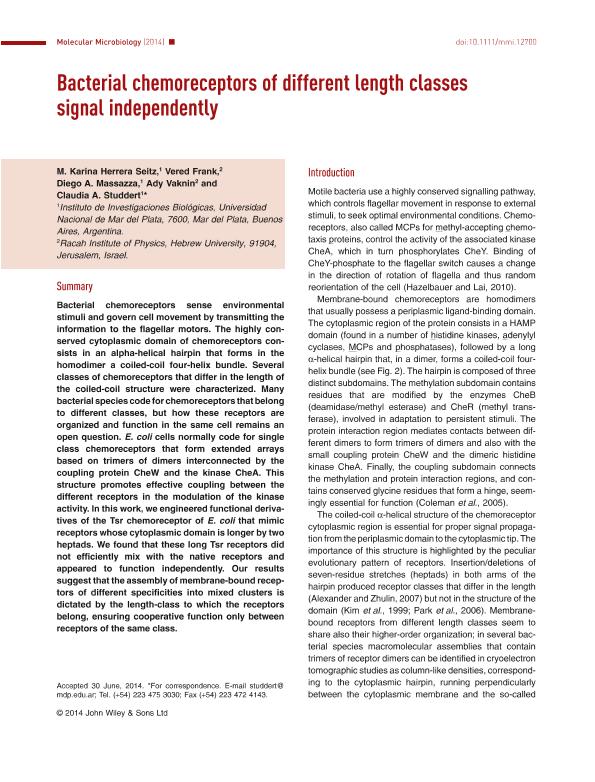Artículo
Bacterial chemoreceptors of different length classes signal independently
Fecha de publicación:
08/2014
Editorial:
Wiley
Revista:
Molecular Microbiology
ISSN:
0950-382X
e-ISSN:
1365-2958
Idioma:
Inglés
Tipo de recurso:
Artículo publicado
Clasificación temática:
Resumen
Bacterial chemoreceptors sense environmental stimuli and govern cell movement by transmitting the information to the flagellar motors. The highly conserved cytoplasmic domain of chemoreceptors consists in an alpha-helical hairpin that forms in the homodimer a coiled-coil four-helix bundle. Several classes of chemoreceptors that differ in the length of the coiled-coil structure were characterized. Many bacterial species code for chemoreceptors that belong to different classes, but how these receptors are organized and function in the same cell remains an open question. E. coli cells normally code for single class chemoreceptors that form extended arrays based on trimers of dimers interconnected by the coupling protein CheW and the kinase CheA. This structure promotes effective coupling between the different receptors in the modulation of the kinase activity. In this work, we engineered functional derivatives of the Tsr chemoreceptor of E. coli that mimic receptors whose cytoplasmic domain is longer by two heptads. We found that these long Tsr receptors did not efficiently mix with the native receptors and appeared to function independently. Our results suggest that the assembly of membrane-bound receptors of different specificities into mixed clusters is dictated by the length-class to which the receptors belong, ensuring cooperative function only between receptors of the same class.
Palabras clave:
Chemotaxis
,
Chemoreceptors
Archivos asociados
Licencia
Identificadores
Colecciones
Articulos(IIB)
Articulos de INSTITUTO DE INVESTIGACIONES BIOLOGICAS
Articulos de INSTITUTO DE INVESTIGACIONES BIOLOGICAS
Citación
Herrera Seitz, Karina; Frank, Vered; Massazza, Diego Ariel; Vaknin, Ady; Studdert, Claudia Alicia; Bacterial chemoreceptors of different length classes signal independently; Wiley; Molecular Microbiology; 93; 4; 8-2014; 814-822
Compartir
Altmétricas




